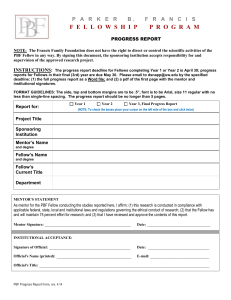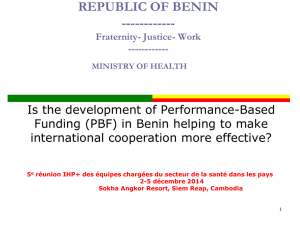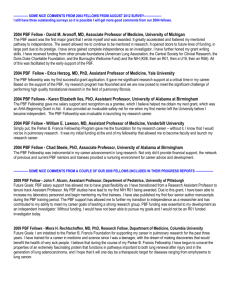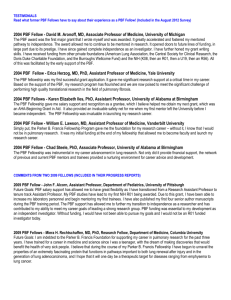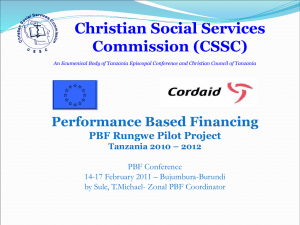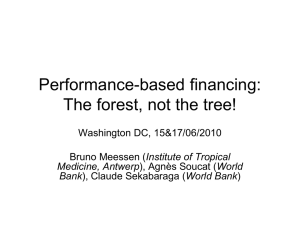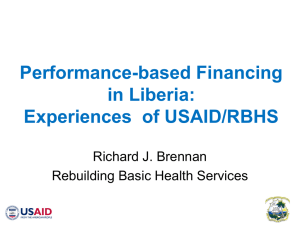UN Peacebuilding Fund Results Framework Outcomes and
advertisement
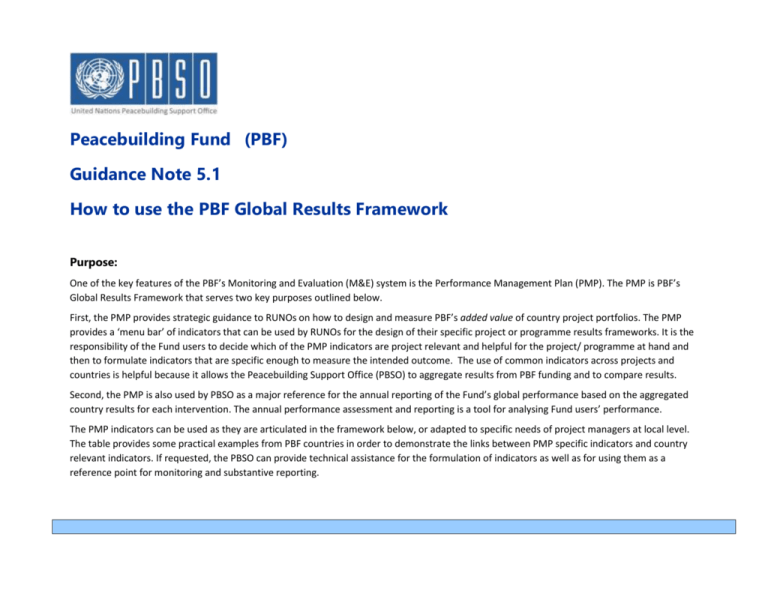
Peacebuilding Fund (PBF) Guidance Note 5.1 How to use the PBF Global Results Framework Purpose: One of the key features of the PBF’s Monitoring and Evaluation (M&E) system is the Performance Management Plan (PMP). The PMP is PBF’s Global Results Framework that serves two key purposes outlined below. First, the PMP provides strategic guidance to RUNOs on how to design and measure PBF’s added value of country project portfolios. The PMP provides a ‘menu bar’ of indicators that can be used by RUNOs for the design of their specific project or programme results frameworks. It is the responsibility of the Fund users to decide which of the PMP indicators are project relevant and helpful for the project/ programme at hand and then to formulate indicators that are specific enough to measure the intended outcome. The use of common indicators across projects and countries is helpful because it allows the Peacebuilding Support Office (PBSO) to aggregate results from PBF funding and to compare results. Second, the PMP is also used by PBSO as a major reference for the annual reporting of the Fund’s global performance based on the aggregated country results for each intervention. The annual performance assessment and reporting is a tool for analysing Fund users’ performance. The PMP indicators can be used as they are articulated in the framework below, or adapted to specific needs of project managers at local level. The table provides some practical examples from PBF countries in order to demonstrate the links between PMP specific indicators and country relevant indicators. If requested, the PBSO can provide technical assistance for the formulation of indicators as well as for using them as a reference point for monitoring and substantive reporting. PBF PERFORMANCE MANAGEMENT PLAN (PMP) Measuring change that impacts conflict dynamics: Overall results of PBF project portfolios Conflict factor: Absence / lack of visible state authorities in conflict affected areas (1) Public confidence and trust: % of PBF supported project portfolios with evidence of positive change in public confidence and trust in state authorities Conflict factor: Lack of state capabilities of crowd control / mob violence (2) Non-relapse into conflicts: % of countries out of total PBF portfolio which did not relapse into conflict a) during period of PBF engagements and b) within 3 and 6 years after PBF funding begins Conflict factor: Perception of threat / distrust among ethnic groups / lack of equity in access to limited resources (3) Peaceful coexistence: % of countries out of total PBF supported project portfolio with evidence that national reconciliation has been improved through the engagements of youth, women, marginalized groups in conflict-affected communities, playing an active role in strengthening social cohesion between potentially conflicting groups at local Conflict factor: Blockage of the peace process (4) Catalytic leverage: % of PBF supported project portfolios with evidence of catalytic leverage either a) in terms of overall peace building relevant processes and institutional reforms, or b) additional funding commitments for peace relevant sectors, both unleashed by PBF results achievements. Priority Area 1. Support to Implementation of Peace Agreements and Political Dialogue PBF Results (outcomes) for measuring programme effectiveness 1. Security sector reforms and judiciary systems put in place and providing services and goods at national and local level that reinforce the Rule of Law (RoL) Theory of change PBF programme practice is effective if it results in more functional institutions of justice and security providing fair and competent services to the population, and reducing then frustration and the potential for instrumentalization of populations to PMP indicators for measuring global Fund performance as aggregated country results that 1.1 Public security / SSRs: # of PBF supported projects where national armed forces and police perform their duties in conflict affected territorial areas addressing security concerns of the target populations (disaggregated by type of duties, urban / rural areas) 1.2 Access to RoL : # of PBF supported projects where communities use Indicator examples for measuring country specific results Outcomes of IRF / PRF portfolios -Improved discipline and performance of police (GUI) -Improved efficiency in State security institutions (NEP) -Reduced break-outs of violent incidents during elections (GUI) -Increased responsiveness of law enforcement institutions protecting safety to local people (LIB) Project specific outputs needed to achieve intended outcomes -# of security agents trained and deployed for ensuring public security in x ‘hot spot areas’ (BDI, LIB, SL) Outcomes of IRF / PRF portfolios -Reduced court case backlog (LIB) undertake violent or extra-legal action transitional justice systems to resolve conflicts/disputes without recourse -Enhanced access to judicial to violence ensuring the respect of Human Rights of women and girls in services around the country (LIB) -Law reform eliminates gender particular (disaggregated by type of conflicts, ethnicity and gender) 1.3 1.4 Reintegrate ex-combattants: # of PBF projects that have successfully integrated ex-combatants into communities or national security forces (disaggregated by type of returnees, ethnicity and gender Implement Peace Agreements: # of PBF projects with evidence that inclusive dialogue drives the implementation process of peace agreements (disaggregated by type of agreements implemented discrimination (CEDAW, SC1325, 1820); (BDI, KYR) Project specific outputs needed to achieve intended outcomes Additional judiciary staff hired & trained to speed up proceeding Outcomes of IRF / PRF portfolios Growing confidence and participation in democratic system (e.g. vote, inter-act with gov officials, conflict mediation skills), BDI, CAR. LIB -Ratio of male/female excombatants reintegrated (DRC) -Acceptance in the communities to which they returned (SUD, DRC, CAR Project specific outputs needed to achieve intended outcomes -Targets of DDR of specific groups met (SUD) Outcomes of IRF / PRF portfolios -% of peace agreement provisions being implemented; (BDI) Technical quality of provisions Project specific outputs needed to achieve intended outcomes -Dialogue process resumed Priority Area 2. Promote coexistence and peaceful conflict resolution PBF Results (outcomes) for measuring programme effectiveness PMP indicators for measuring global Fund performance as aggregated country results that Indicator examples for measuring country specific results 2. Conflicts resolved peacefully and in a manner 2.1 that supports the coexistence of all relevant actors/groups that were involved in conflicts that undermine peace building efforts Theory of change: PBF programme practice is effective if social cohesion at local level becomes a key driver for national reconciliation through inclusive partnerships, the strengthening of democratic institutions and civil society organizations to contribute to the management of root causes of conflicts National Reconciliation: # of PBF country projects with effective partnerships and procedures in place that maintain regular inclusive policy dialogue to address issues of conflict, instability and political participation (disaggregated by: type of inclusive partnership: political parties, civil society organizations, marginalized groups, traditional and religious leaders, and type of issues addressed) Outcomes of IRF / PRF portfolios -Enhanced cross-cultural understanding among youth -Representative participation of women in dialogue, conflict resolution and peacebuilding process -Reduction of incidents of gender based violence -Effective implementation of TRC agreements Project specific outputs needed to achieve intended outcomes -Independent, non partisan media, respecting diversity 2.2 Democratic Governance: # of PBF country projects with democratic institutions in place bearing the trust and confidence of target populations to address most urgent legacy of human rights including corruption (disaggregated by type of commissions / institutions 2.3 Access to Resources: # of PBF country projects with mechanisms in place to address peacefully disputes grounded in competition for access to land and use of limited resources (e.g. land, water) (disaggregated by type of mechanism and dispute (gender, ethnicity) Outcomes of IRF / PRF portfolios - Dedicated, autonomous Human Rights, Land etc. Commissions settle disputes and manage conflicts in transparent and timely fashion at national and local levels (BDI, LIB) -% of women testimonies in TRC -Voter turn-out rates increased/election related violence reduced (LYB, SL) -Active anti-corruption body rules and acts on cases (SL) Project specific outputs needed to achieve intended outcomes - National Commission for Human Rights established (BDI) - Election officials and riot police trained and deployed (SL) Outcomes of IRF / PRF portfolios - Effective resolution of land disputes (property rights) to resume agricultural production (BDI, LIB) - Increased access to economic resources for women headed households (inheritance, land rights etc) (GUI) Project specific outputs needed to achieve intended outcomes -National and local capacities to address disputes and/or emerging conflicts enhanced - Increased access to justice mechanisms (CAR) Priority Area 3: Revitalise the economy and immediate peace dividends PBF Results (outcomes) for measuring programme effectiveness 3. Youth, women and other marginalized members of conflict affected communities, act as a catalyst to prompt the peace process and early economic recovery PMP indicators for measuring global Fund performance as aggregated country results that 3.1 Creation of peace dividends: # of PBF country projects where youth, women and other conflict affected groups acknowledge job opportunities that flow from the supply and demand of the labour market as peace dividends (disaggregated by: ethnicity, gender, urban and rural areas Theory of change PBF programme practice is effective if youth with opportunities to articulate political and social views peacefully (engagement) and earn livelihoods are less easily instrumentalized into extra-legal political conflict and mob violence. 3.2 Livelihood Opportunities: # of PBF country projects generating sustainable livelihood opportunities to IDP, refugees, victims of war and others in need in conflict affected communities (disaggregated by: Target groups (IDPs, refugees, victims of war, youth,women), ethnicity, urban and rural areas Indicator examples for measuring country specific results Outcomes of IRF / PRF portfolios -Enhanced capacity of youth to interact with local government officials and access economic services - change of perceptions of youth and women -Equal rights to economic assets for women granted -Food security of population at large increased Project specific outputs needed to achieve intended outcomes -Vocational training centres providing quality trainings (CAR,KYR) -No. of community service projects completed (water, drainage, road repair, that provided skill training and income for youth and women at risk Outcomes of IRF / PRF portfolios -IDP/refugees returned to communities of their origin (Sri Lanka) Project specific outputs needed to achieve intended outcomes - No of food for work initiatives provided to deplaced households (in especially to women headed households) 3.3 Private sector engagement: # of PBF country projects where partnerships with the private sector play an active role in the delivery of peace dividends (disaggregated by: ethnicity, gender; urban and rural areas) Outcomes of IRF / PRF portfolios -Increased investment of private sector, e.g. numbers of new jobs and businesses created Project specific outputs needed to achieve intended outcomes: - # of business initiatives supported Priority Area 4: (Re-)build essential administrative services and infrastructure PBF Results (outcomes) for measuring programme effectiveness 4. Essential functions of government institutions restored to effectively assume their basic service delivery duties effectively with particular attention to the provision of peace dividends PMP indicators for measuring global Fund performance as aggregated country results that 4.1 Restoring public administration: # of PBF country projects with functional administrations in place at local level to resume basic public services (disaggregated by type administrative functions and related services Theory of change: PBF programme practice is effective if it results in supporting administrative reforms at local level that address unequal access to basic public services as underlying conflict cause, and increasing trust of populations in governments. Indicator examples for measuring country specific results Outcomes of IRF / PRF portfolios: -No. of land disputes peacefully treated by local authorities out of total number submitted - Positive trend of increased trust of local population to state representatives at local level Project specific outputs needed to achieve intended outcomes -No. of administrative buildings / infrastructures rebuilt in previously conflict affected districts 4.2 Public service delivery: # of PBF country projects with evidence that the delivery of peace dividends of a good quality enhances the credibility and legitimacy of, and public trust to local state representatives (disaggregated by type of service delivery, type of beneficiaries: youth, women, marginalized groups, conflict affected communities) Outcomes of IRF / PRF portfolios -Access to basic services of previously excluded groups -No. of people (ethnic minorities) using key services in target areas Project specific outputs as needed to achieve intended outcomes -No. of targeted communities with increased access to services
